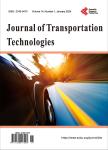A New Approach in Design of a Pavement Reinforced by A Geosynthetic Layer in Severely Stressed Area of the Airport Pavement to Accommodate Stresses Imposed by Aircraft Landing and Ground Movements
A New Approach in Design of a Pavement Reinforced by A Geosynthetic Layer in Severely Stressed Area of the Airport Pavement to Accommodate Stresses Imposed by Aircraft Landing and Ground Movements作者机构:School of Aerospace University of Nottingham Ningbo China Ningbo China
出 版 物:《Journal of Transportation Technologies》 (交通科技期刊(英文))
年 卷 期:2022年第12卷第3期
页 面:346-356页
学科分类:081504[工学-水利水电工程] 08[工学] 0815[工学-水利工程]
主 题:Aircraft Airport Aeronautical Aviation Apron Engineering Pavement Runway Structure
摘 要:Pavements of airport runway and apron are subjected to stern stresses imposed by landing and ground movements of aircraft. The stresses are primarily concentrated in touchdown zone and wheel path areas of the pavement structure. This paper proposes that this area can be designed using geosynthetic layer reinforcement to minimise deflection and deterioration of the structure. The reinforcement can reduce the vertical stresses on the underground fuel pipes in the apron area, if used. The concept of ditch conduit reinforcement is suggested where a geosynthetic layer is used within a soil backfill to redistribute load over a conduit leading to stress redistribution. It is observed that the vertical load is significantly reduced by the arching action of the soil mass overlying the conduit. The load can be reduced further by placing a geosynthetic reinforcement layer within the soil backfill above the conduit. It is suggested that the inclusion of a geosynthetic layer in the granular backfill reduces the vertical load on a ditch conduit and the amount of reduction depends upon the tensile modulus, deflection of the geosynthetic and soil arching action. This leads to believe that a reinforced pavement structure for runway and aerodrome apron area improves the load carrying capacity of the pavement to sustain the operations of heavy transport aircraft, including occasional overloading of the pavement. Hence, this paper explores a possibility of using a geosynthetic layer under the runway pavement to provide reinforcement.



